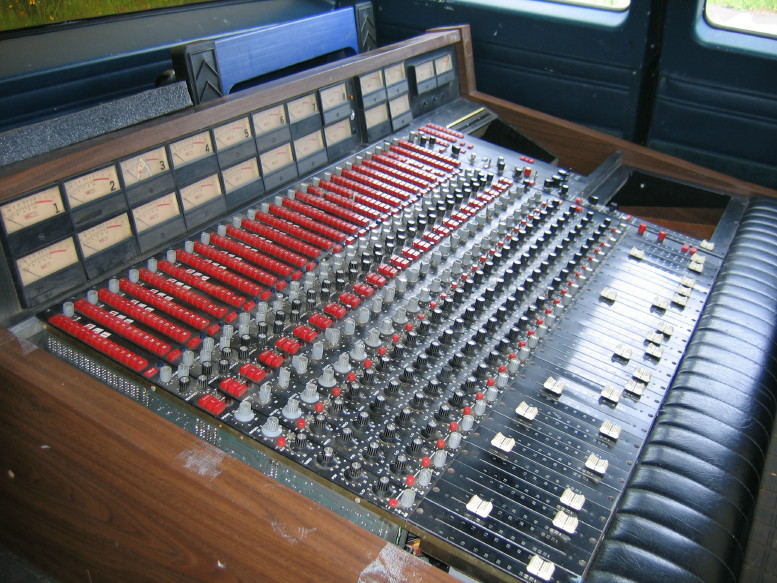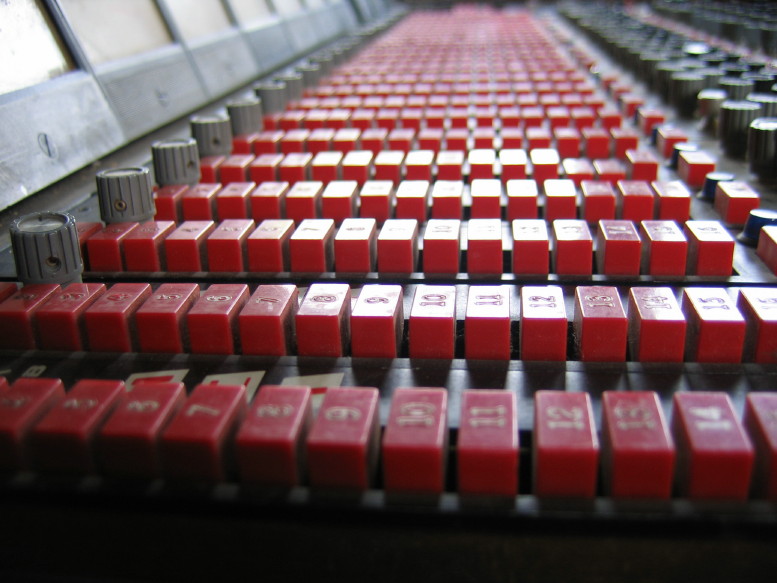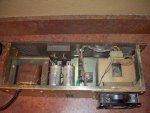You are using an out of date browser. It may not display this or other websites correctly.
You should upgrade or use an alternative browser.
You should upgrade or use an alternative browser.
MCI JH-416 Story...
- Thread starter sweetbeats
- Start date
sweetbeats
Reel deep thoughts...
Where'd ya get that? Good story!
20 minutes from my house if you can believe that...
As is my normal pattern I prioritize low price over functional status...this mixer is missing:
- The power supply
- 4 of the 5 patchbay modules and ALL of the internal harnessing
For #1 I've got my feelers out for a PSU, but not too hopeful of finding one, at least not that I can afford. My alternative if I still haven't found an affordable factory PSU by the time I get the frame re-wired will be to purchase a quartet of Power One modules: a trio of bipolar 24V supplies and a +48V supply. Yep...the audio runs on 24V rails in this thing. Headroom.
For #2, if I can't find OEM MCI patchbays for this (which are 1U half-width 2 x 24 TT units), then I can find older ADC 96pt TT patchbays (as that's where MCI got them, but they're just half the 96pt) and have my machinist friend make faceplates and transfer the guts...and then there's the harnessing...Oy that's gonna be the "ugly" about this project. All the wiring to and from the 240pt patch field is gone and therefore this thing ain't passing audio until I put those trunks back. It will be $100's in cable. I knew I was signing up for that though...
All of the source and output switching is handled by mechanical relays. The good part of that is that it is a mixer that makes audible clicks...I like that...the bad part is they get dodgey so we'll see how well it is working and then look at options for replacing the old reed relays if needed.
It is an opamp-based mixer but the opamps are MCI home-grown: MCI 2001's.
Think character. I think there is a love it or hate it verdict on the sound of these mixers, but they're bound to have tons of character and color with trannies on the inputs and outputs and with those proprietary opamps.
There is tons of room to work on the cards...holy smokes they're HUGE:
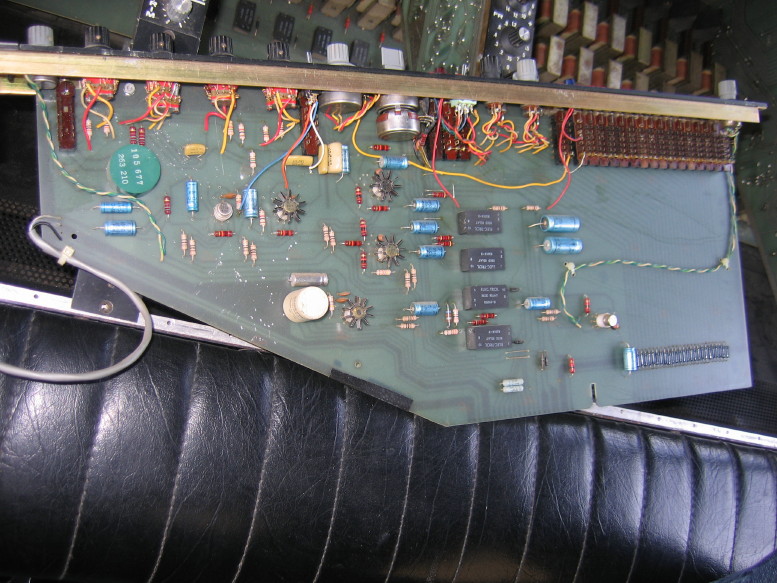
For perspective, those cards are nearly 9" tall! And look at how few components there are on the cards...so much room, so simple.
I'm working on getting my head around the mixer features/topology...what I know is:
- It is an inline console
- It has, like, 16 + 8 groups...groups 1~16 are available to channels 1~16 and groups 9~24 are available to channels 17~24.
- There are 4 auxes, 2 pre and 2 post, and one of the post sends is switcheable pre/post in one of the global mixer modes.
- EQ is 3 band, swept mids but the upper and lower shelving each have two selectable knee points, and the mid band has, ummm...12 selectable frequencies and is either boost or cut (switch selectable)...the boost/cut knobs are detented. So that might seem limited but I actually like it. My understanding is that having detented points mitigates potential for phase distortions and also makes EQ settings easier to duplicate channel-to-channel. I'm stoked. Each band when set to "0" is a hardwire off setting so you really have 3 independent EQ bands as far as having them engaged or disengaged. Only need to cut some mud? Leave the hi and lo shelving off at "0" and only switch in the mid band.
- I get fuzzy on this next point...this is a quad mixer, so not only do you have 16 + 8 groups, but you also have a 4-channel master buss (2 front, 2 rear). The quad buss is further able to be monitored in stereo or mono, so depending on where you are picking up your monitor source the mixer is sort of a 24 x 24 (16 + 8) x 4 x 2 x 1. So anyway, each channel can be sent to any one or two of the quad channels...and each channel has a monitor buss as well.
- There are global mixer status switches that basically set the mixer into either tracking ("MIKE"), overdubbing ("REMIX") or mixdown ("TAPE") modes but each input module has some local override control of the global status.
- Meters are the same as the large Dixson meters fitted to Ampex AG-440 and 440B electronics modules. I'm very fond of their look and ballistics. Meter sourcing is flexible on the quad and stereo master meters.
- No jacks on this thing...there are large connector blocks on the back that interface with the motherboard, patch field and all external gear.
- Faders are really nice Penny & Giles conductive plastic units...each has a big ol' plug with gold-plated terminals for quick disconnect from its associated board.
- Of course the master section has talkback features and the studio and control room sourcing has a full compliment of options. The master section also features 4 "echo" returns which are routable to the quad busses.
- There is oscillator sourcing available but you have to supply the oscillator...the console just has facilities for patching it in and routing it via the control surface. Fortunately it looks like a nice oscillator came with the mixer.
- This mixer is probably from 1973 or possibly 1974.
- Again, kind of getting my head around the gozintas and gozoutas...naming conventions for I/O facilities are a little different than what we use today, but basically each channel has a mic input, direct out, insert, tape out, and tape in, all transformer balanced.
- Phantom power is global and provided by an external supply if the operator so chooses.
Some more pics:
3 of the 5 master modules ("Control" room, "Studio" and "Meter" source/mixer status modules):
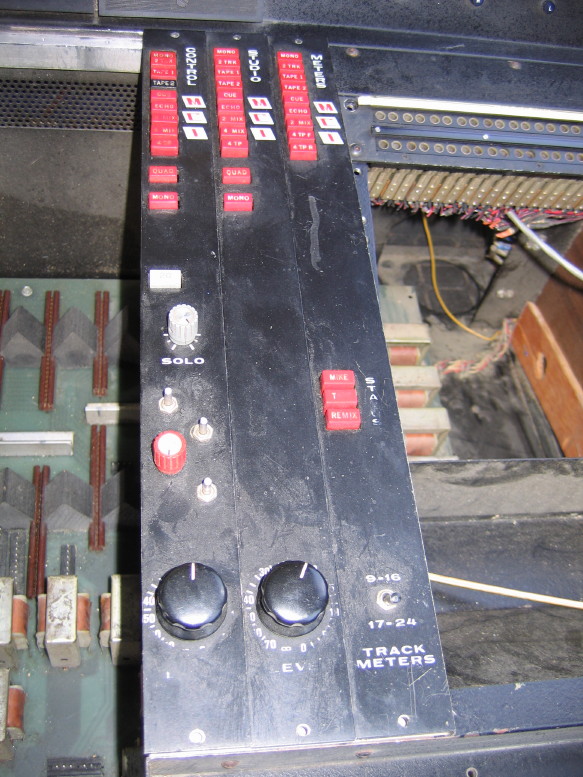
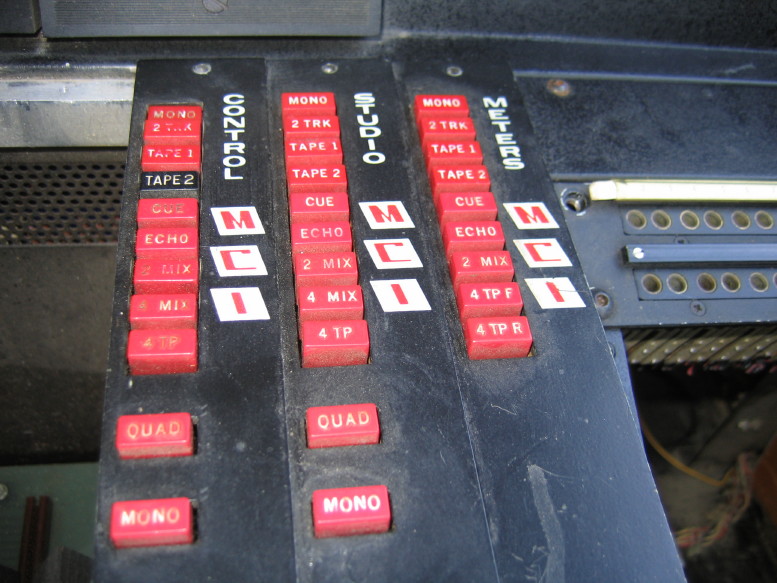
This is the "Control" room PCB...lookit the size of that quad master pot...the blue can:
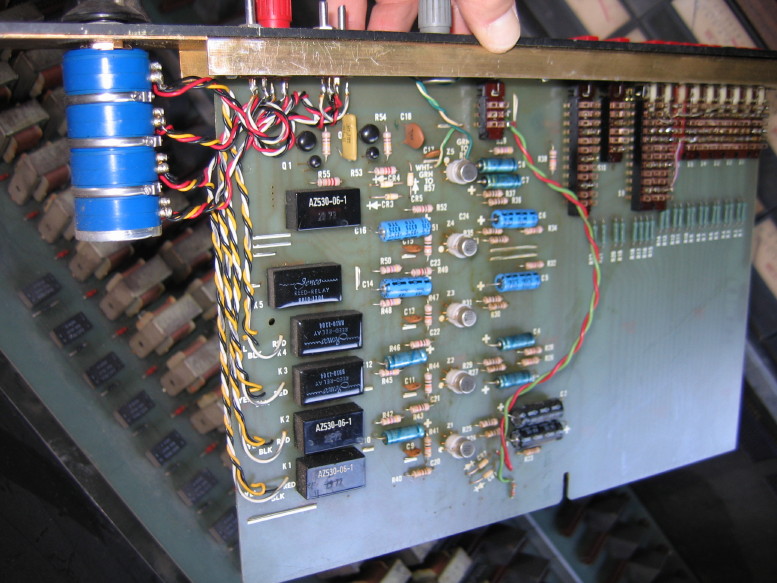
The oscillator unit:
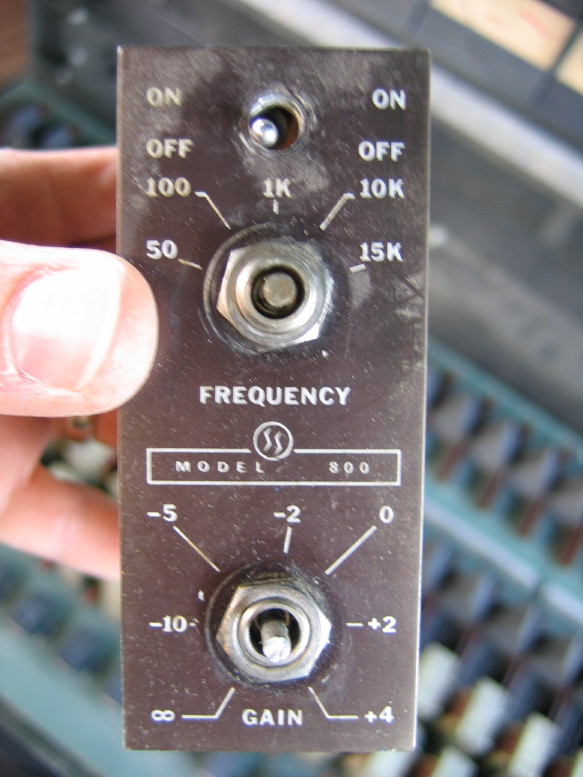
The motherboard:
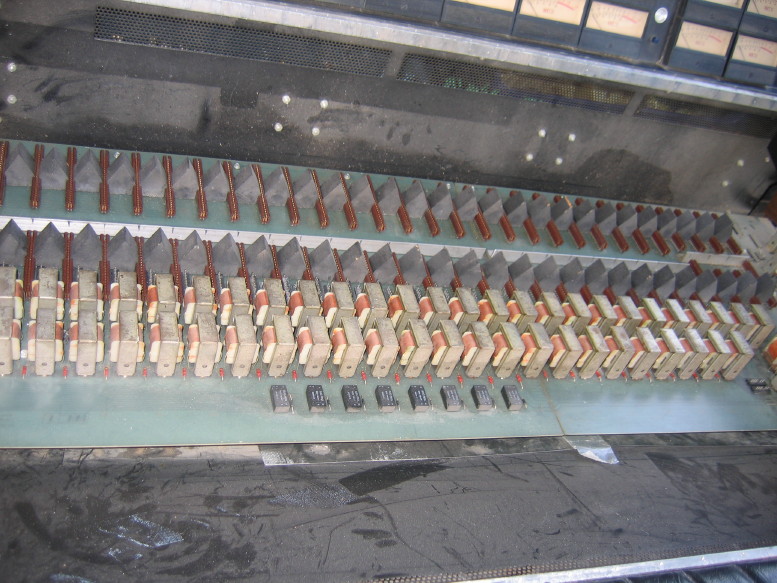
Here's a shot of one of the locking plugs for the P&G faders:
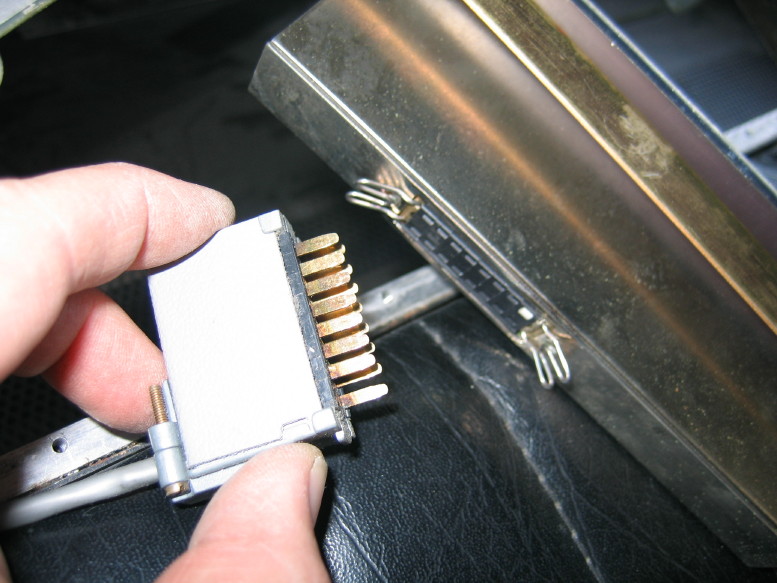
I couldn't help myself...I just want to see how well its going to clean up. Started with the "Meter" module since it is small and simple, and just cleaning up the switch caps so far. It'll be pretty nice I think...before and after:
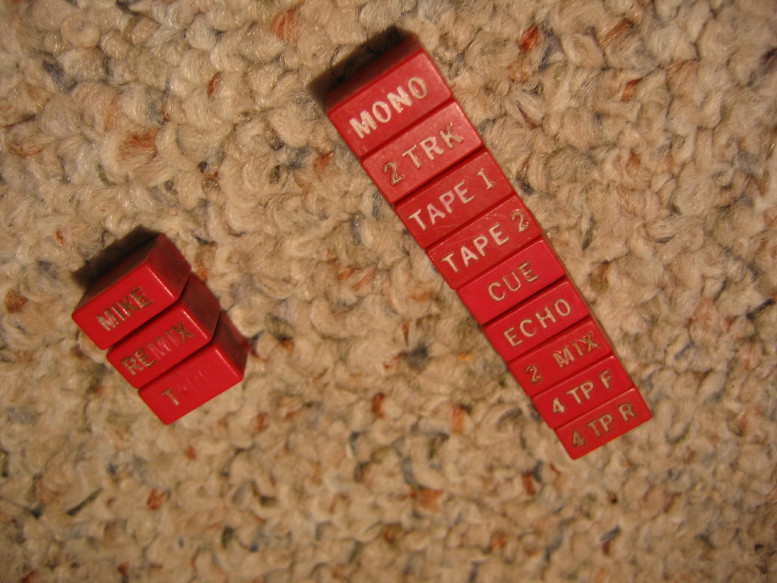
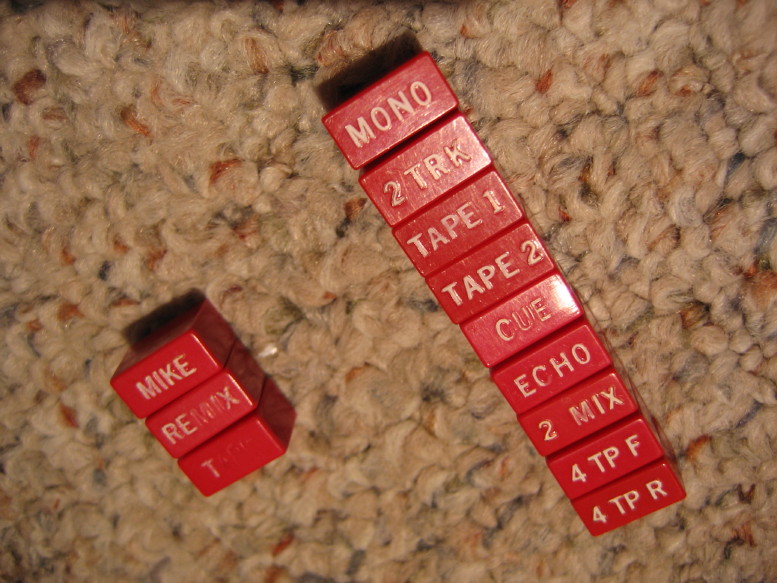
That's all for now...back to work on the Soundtracs mixer (which will be the mainstay for quite a time I imagine as the MCI desk will take quite some time), and prepping the Tascam 388 for sale.
Oh, and Brian, yeah, I couldn't help it...had to get the "Story" going.

BTW, I have a parallel thread going over at the MCI forum here: My JH-416
Blue Jinn
Rider of the ARPocalypse
Wow, transformer coupled too. That is going to have some character. Is there a particular reason you can't redo the harnessing to avoid the patch bays, and "normal" some of the connections to save time/effort. IOW "mod" rather than "restore?" Are you sure that's a pot on the master module, or (even better) an attenuator?
Nice discrete I/O too, heatsinks on the transistors....
Nice discrete I/O too, heatsinks on the transistors....
sweetbeats
Reel deep thoughts...
I've thought about that...just wiring straight to the punch blocks on the back. Still pondering that...I do love the look and functionality of those built-in TT patchfields.
I think you're right on that "pot"...I now recall reading that it is an attenuator.
Those heatsinks are on the MCI 2001 opamps, not transistors. Its not discrete.
I think you're right on that "pot"...I now recall reading that it is an attenuator.
Those heatsinks are on the MCI 2001 opamps, not transistors. Its not discrete.
Wow. I saw the title of this thread, and had only one thought --- "what now?" lol
The studio I went to school at used to have an MCI console - don't remember what the model was, but I remember stories of having to do recaps of at least one channel strip before each major recording session just to keep it alive. And one recording session, there was a Zucchini-sized cap in the power supply that decided to explode! Looks like a fun beast - not sure what to tell you about all the missing stuff though.
The studio I went to school at used to have an MCI console - don't remember what the model was, but I remember stories of having to do recaps of at least one channel strip before each major recording session just to keep it alive. And one recording session, there was a Zucchini-sized cap in the power supply that decided to explode! Looks like a fun beast - not sure what to tell you about all the missing stuff though.
Last edited:
briank
analog for the people!
Wow. I saw the title of this thread, and had only one though --- "what now?" lol
The studio I went to school at used to have an MCI console - don't remember what the model was, but I remember stories of having to do recaps of at least one channel strip before each major recording session just to keep it alive. And one recording session, there was a Zucchini-sized cap in the power supply that decided to explode, the burning guts of which decided to fly everywhere and cinge the legs of the engineers and artists sitting at the desk listening to their session. HA! Looks like a fun beast - not sure what to tell you about all the missing stuff though.
Errr, mebbe I'd better re-cap the PSUs for the MCI I just bought sooner than later...and move the PSUs away from my legs in the meantime. Those big blue Mallorys in the peripheral supply are scary!



Cory, the pic of that CR module just kills me...so nice and simple and lots of space! I recapped the monitor module in my 600 a couple weeks ago and all I can say is even though it's the easiest module to do, I'd have rather done your 400's
 That 400 is going to be a big project, it's a bummer about all the missing wiring, but man what a cool beast, and a piece of history--one of the first inline consoles. The photo of the belly pan with the rows of iron is just great! I'm interested by the gold-plated locking cinch connectors on the fader packs, that's really nice. MCI had gone to the pesky Molexes for the 600 series.
That 400 is going to be a big project, it's a bummer about all the missing wiring, but man what a cool beast, and a piece of history--one of the first inline consoles. The photo of the belly pan with the rows of iron is just great! I'm interested by the gold-plated locking cinch connectors on the fader packs, that's really nice. MCI had gone to the pesky Molexes for the 600 series.
Last edited:
Blue Jinn
Rider of the ARPocalypse
I totally spaced reading earlier about the "home grown opamps...."
As for relays, that should be fairly standard, I did a bit of research on that when I though maybe a relay was a culprit on my other Otari. There really isn't a whole lot of variation just xPxT and voltage rating and pinout although the footprints seemed fairly consistent as well. (At least for Omron)
As for relays, that should be fairly standard, I did a bit of research on that when I though maybe a relay was a culprit on my other Otari. There really isn't a whole lot of variation just xPxT and voltage rating and pinout although the footprints seemed fairly consistent as well. (At least for Omron)
sweetbeats
Reel deep thoughts...
I'd say shame on somebody for not drilling down on that issue before it risked harm to others. Seriously. If caps keep frying or fuses keep blowing or whatever, it is a sign that something isn't well and that was confirmed when the PSU blew. Everything I've seen so far (which is all the guts) tells me this thing is built like a tank. The power supply design calls for a supply that can handle a relatively large amount of current. Its pretty beefy. My point is that I'd be really surprised if the temperment of the MCI console you mentioned is the norm.
sweetbeats
Reel deep thoughts...
Well, here's the deal...My Ampex MM-1000 has just simply become IT for me. It just simply fits. Its idiosyncrasies, its blemishes, and of course all its greatness too. I like my Soundtracs mixer just fine. It will serve me well and I'm in the home stretch of what I intend to accomplish before I put it into service, but to be honest it does not feel like that same fit as I have with the Ampex. I decided to pick up the MCI desk because it feels the same way...its idiosyncrasies, blemishes, and all its greatness. After all the refurb experiences I've been through, though it has been lots of work, it has also been a tremendous education and I have confidence now in knowing what is IT. The MCI is it. Realistically it is likely to be 2 to 3 years before the MCI is ready. The Soundtracs mixer will serve me well in that time and then I will find another home for it. So its all good.
Procuring the MCI puts everything into perspective for me with regard to other items I have here like the 388 and the M-__ mixer. I'm definitely attached to them, but realistically I haven't the space to have them setup and in operation and I don't need them...I don't "need" any of this stuff but when you have devices that so clearly take priority then you "need" the others even less.
So anyway, thanks for the concern, but having the Soundtracs mixer will allow my music room to operate and to be able to enjoy it leaving the MCI refurb to be taken at a pace with no pressure...to savor and enjoy.
Procuring the MCI puts everything into perspective for me with regard to other items I have here like the 388 and the M-__ mixer. I'm definitely attached to them, but realistically I haven't the space to have them setup and in operation and I don't need them...I don't "need" any of this stuff but when you have devices that so clearly take priority then you "need" the others even less.
So anyway, thanks for the concern, but having the Soundtracs mixer will allow my music room to operate and to be able to enjoy it leaving the MCI refurb to be taken at a pace with no pressure...to savor and enjoy.
briank
analog for the people!
Cory, your post resonated with me for sure. I think we're similar creatures in many regards and I wasn't too surprised at all when you came up with an early MCI project! We're both suckers for beefy gear with lots of character and personality and an interesting tactile experience--the click of a Schadow switch or relay, the whir of a big heavy reel motor, the sweep of a mechanical VU meter and the subtlety of its ballistics. We're totally nuts  I also dig the "underdog" nature of MCI's early days.
I also dig the "underdog" nature of MCI's early days.
Thinking about what I said in my previous post about this 400 being one of the first inline consoles...actually, if this is a 416, it IS the first, and indeed set the precedent for that segment of the industry, it really IS an important piece of console history as were all three of MCI's console series (400s: first inline console, 500s: set the precedent for a new era of complex, fully featured beasts that, after a few years in the market, was a bit ripped off by a new company who called their version the "SSL 4000" 600s: the first commercially produced automated analog consoles, and all had a solid pedigree of hit music). If ever there was a piece of kit that deserved the Sweetbeats Treatment, that 416 is it! The MM1000 through it will be heavenly and worth the time and effort!
600s: the first commercially produced automated analog consoles, and all had a solid pedigree of hit music). If ever there was a piece of kit that deserved the Sweetbeats Treatment, that 416 is it! The MM1000 through it will be heavenly and worth the time and effort!
I'm excited to see how it goes, and particularly as a new owner of a 600 series. The 600s were the 400's replacement for the 80's and it's a real hoot to see how much the market changed in less than a decade and how different MCI's design ethos had to change to satisfy it--these console really speak to a very different market, they're the two very different sides of the same coin, really.
Muckelroy, yeah, that studio mustn't have quite learned that you really have to stay on top of maintenance with MCIs, and particularly the complicated 500 and 600 series. Much as MCIs are notorious for becoming pretty grouchy after 20 or 30 years, I have NOT been regaled with tales of MCIs blowing up and injuring people so I would say they had some real maintenance shortfalls with that puppy. That said, I'm still gonna get my PSUs away from my legs...LOL! Gonna take another few hundred bucks I don't yet have to finish refurbing those mofos, still need to sell a couple unneeded consoles to make my MCI project happen, as with Cory's project!
 I also dig the "underdog" nature of MCI's early days.
I also dig the "underdog" nature of MCI's early days. Thinking about what I said in my previous post about this 400 being one of the first inline consoles...actually, if this is a 416, it IS the first, and indeed set the precedent for that segment of the industry, it really IS an important piece of console history as were all three of MCI's console series (400s: first inline console, 500s: set the precedent for a new era of complex, fully featured beasts that, after a few years in the market, was a bit ripped off by a new company who called their version the "SSL 4000"
 600s: the first commercially produced automated analog consoles, and all had a solid pedigree of hit music). If ever there was a piece of kit that deserved the Sweetbeats Treatment, that 416 is it! The MM1000 through it will be heavenly and worth the time and effort!
600s: the first commercially produced automated analog consoles, and all had a solid pedigree of hit music). If ever there was a piece of kit that deserved the Sweetbeats Treatment, that 416 is it! The MM1000 through it will be heavenly and worth the time and effort!I'm excited to see how it goes, and particularly as a new owner of a 600 series. The 600s were the 400's replacement for the 80's and it's a real hoot to see how much the market changed in less than a decade and how different MCI's design ethos had to change to satisfy it--these console really speak to a very different market, they're the two very different sides of the same coin, really.
Muckelroy, yeah, that studio mustn't have quite learned that you really have to stay on top of maintenance with MCIs, and particularly the complicated 500 and 600 series. Much as MCIs are notorious for becoming pretty grouchy after 20 or 30 years, I have NOT been regaled with tales of MCIs blowing up and injuring people so I would say they had some real maintenance shortfalls with that puppy. That said, I'm still gonna get my PSUs away from my legs...LOL! Gonna take another few hundred bucks I don't yet have to finish refurbing those mofos, still need to sell a couple unneeded consoles to make my MCI project happen, as with Cory's project!
Last edited:
j.harv
@#$%
Hey Sweetbeats.
Just came across this on CND craigslist.
Not too sure if its the exact model as yours.I just thought you'd be interested in seeing the asking
price!!!!!
MCI mixing console 1974 24 channel
Just came across this on CND craigslist.
Not too sure if its the exact model as yours.I just thought you'd be interested in seeing the asking
price!!!!!
MCI mixing console 1974 24 channel
Muckelroy, yeah, that studio mustn't have quite learned that you really have to stay on top of maintenance with MCIs, and particularly the complicated 500 and 600 series. Much as MCIs are notorious for becoming pretty grouchy after 20 or 30 years, I have NOT been regaled with tales of MCIs blowing up and injuring people so I would say they had some real maintenance shortfalls with that puppy. That said, I'm still gonna get my PSUs away from my legs...LOL! Gonna take another few hundred bucks I don't yet have to finish refurbing those mofos, still need to sell a couple unneeded consoles to make my MCI project happen, as with Cory's project!
Just to set the record straight-- I have nothing but the utmost respect for the engineers who are involved in the aforementioned studio That MCI wasn't new when it was installed, and it came from having heavy commercial use, to more heavy commercial use AND recording students. So you bet it was tired and grumpy. The guys who run that studio are awesome. Just wanted to put that out there incase they read this. The decision was made to replace the MCI console as the time and cost of a full-out overhaul would exceed that of a new console. Unsure of the whereabouts of that old MCI. Anyway thanks for hearing me out

sweetbeats
Reel deep thoughts...
Hey Sweetbeats.
Just came across this on CND craigslist.
Not too sure if its the exact model as yours.I just thought you'd be interested in seeing the asking
price!!!!!
MCI mixing console 1974 24 channel
Yup! Same exact model...might be slight differences in features but its the same board. Trick is I bet that one has harnessing and a power supply, and we can see it has the full patchbay.

I doubt the seller will find a buyer at that price, but a restored JH-400 does command a pretty good price from the right buyer.
I knew this from the beginning which is why I feel pretty good about $200 for mine even with it missing what its missing.
BTW, I believe I have already located a factory PSU in working condition with cable for $125 + S&H.
briank
analog for the people!
BTW, I believe I have already located a factory PSU in working condition with cable for $125 + S&H.
Ah, cool! Hope that works out. I'm curious to see what's inside a 400 PSU! (If anything like the JH110s or 600s, probably a half dozen tall scary looking caps, a small regulator board and a BIG heavy chunk of iron all in a case made of old tank parts hehe)
sweetbeats
Reel deep thoughts...
P
pianodano
Guest
You probably already know about this site dedicated to Jeep Harned, but here it is anyway. American ingenuity and manufacturing at it's best. Seem like everybody stole his ideas. MCI - Designer and Manufacturer of the Professional Audio Recording Equipment
sweetbeats
Reel deep thoughts...
Yeah, thanks, Danny. I DID find that and have a parallel thread going over there.
Yeah, Mr. Harned's ideas did go lots of places, but Its interesting to note that the first series of open reel machines they produced looked an awful lot like Ampex 440 fare. In fact the amp cards are interchangeable, as are the electronics power supplies. Hmmm.
Yeah, Mr. Harned's ideas did go lots of places, but Its interesting to note that the first series of open reel machines they produced looked an awful lot like Ampex 440 fare. In fact the amp cards are interchangeable, as are the electronics power supplies. Hmmm.

